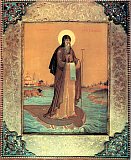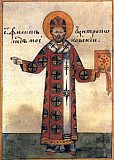

| Previous day | Next day |
| Old Style
July 3
|
Tuesday |
New Style
July 16
|
| 4th Week after Pentecost. Tone 2. | No fast.
|
![]() Martyr Hyacinth of Caesarea in Cappadocia (108).
Martyr Hyacinth of Caesarea in Cappadocia (108). ![]() Second translation of the relics of Hieromartyr Philip, metropolitan of Moscow and all Russia (1652).
Second translation of the relics of Hieromartyr Philip, metropolitan of Moscow and all Russia (1652).
Martyrs Diomedes, Eulampius, Asclepiodotus, and Golinduc (2nd c.). Martyrs Mocius and Mark (4th c.). St. Alexander, founder of the Monastery of the Unsleeping Ones, Constantinople (ca. 430). St. Anatolius, patriarch of Constantinople (458). St. Anatolius, recluse, of the Near Caves in Kiev (12th c.) and St. Anatolius (another), recluse, of the Far Caves in Kiev (13th c.). Repose of St. Basil, bishop of Ryazan (1295). Sts. Basil and Constantine, princes of Yaroslavl (13th c.). Sts. John and Longinus of Yarenga, monks of Solovki (1561). Blessed John of Moscow, fool-for-Christ (1589). St. Nicodemus of Khozyuga, monk of Kozhaezersk Monastery (1640). St. Basil, archbishop of Novgorod (1352). Blessed Michael, Herodion, Basil, and Thomas, fools-for-Christ, of Solvychegodsk (17th c.).
New Hieromartyr Anthony (Bystrov), archbishop of Arkhangelsk and Kholmogorsk (1931).
“Milk-Giver” Icon of the Most Holy Theotokos of Hilandar, Mt. Athos.
St. Anatolius, bishop of Laodicea, and his successor, St. Eusebius (3rd c.). St. Germanus, bishop of the Isle of Man and enlightener of Peel, nephew of St. Patrick of Ireland (474). St. Isaiah the Solitary, of Scetis and Palestine (ca. 489). St. Symeon the Stylite (the third), of Cilicia (6th c.). St. George the Godbearer, of the Black Mountain, teacher of St. George of Mt. Athos (1068). St. Joachim, monk, of Notena in Achaia (17th c.). New Monk-martyr Gerasimus the New, of Carpenision, at Constantinople (1812). Martyrs Theodotus and Theodota, martyred with St. Hyacinth at Caesarea in Cappadocia (108).
Repose of Nun Euphrosyne “the Unknown,” of Kolyupanovo (Aleksin) (1855).
Thoughts for Each Day of the Year
According to the Daily Church Readings from the Word of God
By St. Theophan the Recluse

Tuesday. [Rom. 10:11-11:2; Matt. 11:16-20]
The Lord says that we, not heading the Gospels, are like those to whom merry songs are sung, but they do not dance; sad songs are sung, and they do not cry. You cannot do anything with them. We are promised the heavenly Kingdom, most bright and joyous, but we are unmoved, as if they were not speaking to us. We are threatened with impartial judgment and unending torments, but we are not alarmed; it is as if we do not hear. Downtrodden, we have lost all feeling of true self-preservation. We move as ones being led directly to destruction, and haven’t a care for our destiny. We have lost heart, given ourselves over to carelessness—what will be, will be! Look at our state! Isn’t this why suicides are so frequent? It is the fruit of modern teachings and views on man and his [in]significance! There is progress for you! There is enlightenment! It would be better to be totally ignorant, but save your soul with fear of God, than, having attained the title of an enlightened person, to perish unto the ages, never thinking your entire life about what will happen after death. Not a single jot shall pass from the word of God, which describes both the heavenly kingdom and hell—all will be as it is written. Take this to heart, everyone, as something which touches you personally; and take care for yourself, with all your strength, and as long as time remains.
Articles
 Martyr MociusThe Holy Martyrs Mocius and Mark were arrested as Christians and brought to trial by the governor Maximian. |
 Martyr MarkThe Holy Martyrs Mocius and Mark were arrested as Christians and brought to trial by the governor Maximian. |
 St Basil the Bishop of Ryazan |
 Right-believing Prince Basil of Yaroslavl |
 Right-believing Prince Constantine of YaroslavlIn their youth they lost their father, Vsevolod, who fell in battle with the Tatars (Mongols). St Basil, the elder brother, succeeded to the throne. |
 Venerable Nicodemus the Abbot of Kozhe Lake |
 St George the God-BearerSaint George the God-bearer and Recluse labored in the Black Mountains near Antioch during a time when the churches and monasteries there flourished. |












